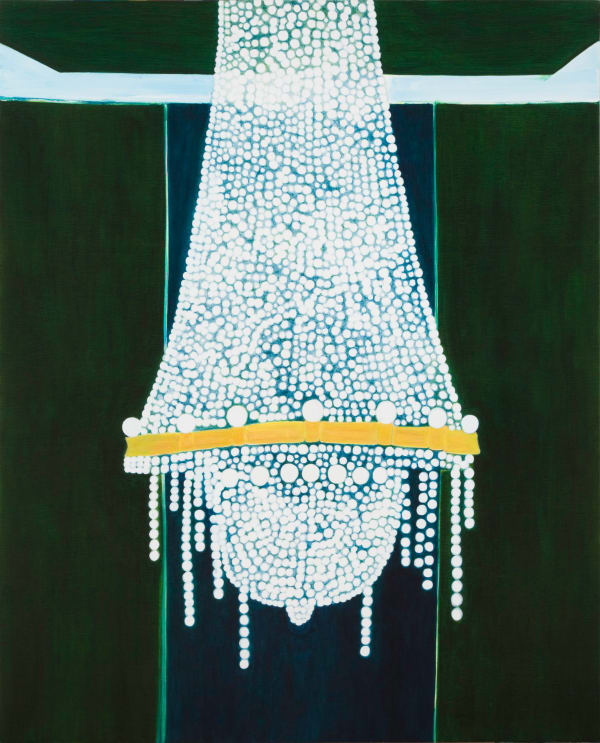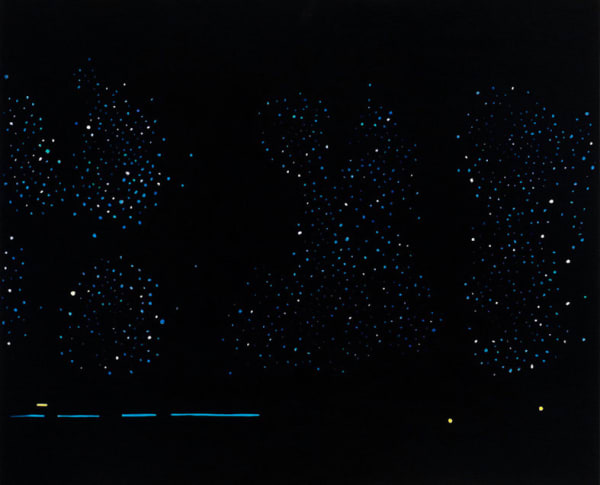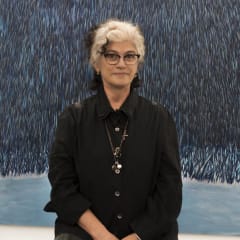Fresta Patricia Leite
Past exhibition
Overview
At first, there seems to be few less inspiring places to write about Patricia Leite’s paintings then a village in the outskirts of Cologne, Germany. The temperature hovers around zero degrees celsius, the landscape littered with dead trees, houses and buildings arranged in a repetitive sequence, in shades of white, gray, beige and dark green. The sky, obscured by a thick layer of clouds, does not recall any memories of distant sunny beaches, marked by the encounter of the sand, the sea and the solid blue of the sky, except for a single, a melancholy memory: that of an almost physical longing for heat and expansion provided by open space; a look that tries to go as far as the eye can see, on a deserted, luminous day at the beach.
However, in the artist’s studio, in Belo Horizonte, in a sort of underground room, below the house swimming pool and used as a balcony, what one sees is the projection of a comprehensive and ugly view of the city’s urban sprawl on the landscape, nowadays completely lacking character after years of greedy real estate speculation so typical of medium size and large Brazilian cities. From inside this small studio, we come across one of the fundamental questions of Patricia’s paintings: do they represent a kind of archeology of the look? do they recall past landscapes that are now submerged under the weight of occupation of all spaces? Wouldn’t this be, however, a local and personal interpretation of the artist’s work? And couldn’t it be then that when we are in a unfamiliar place – on the gray outskirts of Cologne in winter, for instance – inversely thought of as the melancholy of displacement and consequent loss of a beloved landscape? Would Patricia’s paintings evoke holidays sought by any petit bourgeois? A deserted beach, a circus or a countryside soccer field, a journey by river or simply time left for contemplation?
In the midst of this ambiguity and highly personal imagery, emerges a “subject” stemming from the artist’s own experience – a vacation trip or a scene from a recent movie – and another composed of ideal, idyllic images sought after by all sorts of people, a structure of simplified shapes, lines and colors, which gives unity to the work, allowing it to remain and develop.
The starting point is not so much the source of the image itself, but rather the question: given this source, this picture I found when I returned from vacation, for example, how can I condense its elements in order to give them unity within the plane of the canvas? What kinds of solutions will be necessary to abstract this image, make it lean, and still, project it not only as a recognizable landscape, but also as a painting from which new relationships, new contacts, new perceptions between two colors emanate, and therefore, between them and the line that follows this encounter. When we look at the paintings – or perhaps chassis, since the paintings are on wood – we are forced to go beyond the simple recognition of a figuration or “theme, and looked more closely at colors that create a line or form the mass of a shape. This framework of formal simplification – which structures or bases the landscape on the artist’s wishes and memories – also implies a relationship with the painter’s affection for the pictorial tradition of the past, another important reference point in his works. Here, there is a direct dialogue – internalized in the work – with painters that flirted with the European heritage and that started from a point of view of popular art, such as Volpi and his banners, or Lorenzato and his dirt roads and trees, to name a few Brazilians. Painters who instigated viewers to look not only for a configuration or a “theme”, but also formal solutions, especially when small, humble and personal. These solutions are first committed to the painting and second to what they actually represent.
In this sense, these shapes of color on wood maybe find something in common with the trajectory of a painter like Ellsworth Kelly, who remained seperate frominimalism, though he sought simplicity, passionately absorbing abstraction by means of solid colors and lines. The same emotional relationship that the artist cultivates with the different choices of “themes” is established in the game the construction of formal structures. The conversation is not with the solution itself, but what it contains that is personal and non-transferable. How does one bring light into a line? How does one make a single dot shine on a black canvas? These issues are raised and brought into dialogue with artists of other generations, which somehow can only exist in the silence of the look and in the hard, daily work in the studio.
In this context, Patricia Leite’s work, with a career of over twenty years, can transit between abstract and figurative, not having to adhere to any hierarchies, by a hedonism that seeks past and lost paradises, while reiterating pleasure, present in the act of painting with paints and brushes: colors, lines, shapes, composition, canvas, image.
– Ricardo Sardenberg, Cologne, Germany
January 26, 2012
However, in the artist’s studio, in Belo Horizonte, in a sort of underground room, below the house swimming pool and used as a balcony, what one sees is the projection of a comprehensive and ugly view of the city’s urban sprawl on the landscape, nowadays completely lacking character after years of greedy real estate speculation so typical of medium size and large Brazilian cities. From inside this small studio, we come across one of the fundamental questions of Patricia’s paintings: do they represent a kind of archeology of the look? do they recall past landscapes that are now submerged under the weight of occupation of all spaces? Wouldn’t this be, however, a local and personal interpretation of the artist’s work? And couldn’t it be then that when we are in a unfamiliar place – on the gray outskirts of Cologne in winter, for instance – inversely thought of as the melancholy of displacement and consequent loss of a beloved landscape? Would Patricia’s paintings evoke holidays sought by any petit bourgeois? A deserted beach, a circus or a countryside soccer field, a journey by river or simply time left for contemplation?
In the midst of this ambiguity and highly personal imagery, emerges a “subject” stemming from the artist’s own experience – a vacation trip or a scene from a recent movie – and another composed of ideal, idyllic images sought after by all sorts of people, a structure of simplified shapes, lines and colors, which gives unity to the work, allowing it to remain and develop.
The starting point is not so much the source of the image itself, but rather the question: given this source, this picture I found when I returned from vacation, for example, how can I condense its elements in order to give them unity within the plane of the canvas? What kinds of solutions will be necessary to abstract this image, make it lean, and still, project it not only as a recognizable landscape, but also as a painting from which new relationships, new contacts, new perceptions between two colors emanate, and therefore, between them and the line that follows this encounter. When we look at the paintings – or perhaps chassis, since the paintings are on wood – we are forced to go beyond the simple recognition of a figuration or “theme, and looked more closely at colors that create a line or form the mass of a shape. This framework of formal simplification – which structures or bases the landscape on the artist’s wishes and memories – also implies a relationship with the painter’s affection for the pictorial tradition of the past, another important reference point in his works. Here, there is a direct dialogue – internalized in the work – with painters that flirted with the European heritage and that started from a point of view of popular art, such as Volpi and his banners, or Lorenzato and his dirt roads and trees, to name a few Brazilians. Painters who instigated viewers to look not only for a configuration or a “theme”, but also formal solutions, especially when small, humble and personal. These solutions are first committed to the painting and second to what they actually represent.
In this sense, these shapes of color on wood maybe find something in common with the trajectory of a painter like Ellsworth Kelly, who remained seperate frominimalism, though he sought simplicity, passionately absorbing abstraction by means of solid colors and lines. The same emotional relationship that the artist cultivates with the different choices of “themes” is established in the game the construction of formal structures. The conversation is not with the solution itself, but what it contains that is personal and non-transferable. How does one bring light into a line? How does one make a single dot shine on a black canvas? These issues are raised and brought into dialogue with artists of other generations, which somehow can only exist in the silence of the look and in the hard, daily work in the studio.
In this context, Patricia Leite’s work, with a career of over twenty years, can transit between abstract and figurative, not having to adhere to any hierarchies, by a hedonism that seeks past and lost paradises, while reiterating pleasure, present in the act of painting with paints and brushes: colors, lines, shapes, composition, canvas, image.
– Ricardo Sardenberg, Cologne, Germany
January 26, 2012
Works
Installation Views








